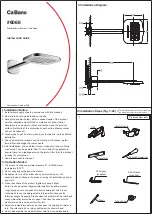
2
T: (1) 866-312-1652
General Considerations
When planning the installation of emergency safety showers and eye/face wash equipment, the advice of a qualified first
aid representative or medical advisor should be sought to establish the most suitable location and procedures for first aid
and decontamination.
Installation should be in accordance with local legislation and industry standards such as EN15154 and/or
ANSI Z358.1-2014 recommendations. Visit www.hughes-safety.com/standards for more information.
•
Emergency safety showers and eye/face wash equipment must be installed within 20 metres, or 10 seconds reach
of, and on the same level as, a potential hazard. Where strong acids or caustics are used, equipment must be
immediately adjacent to the hazard and outside of any spray paths.
•
Equipment must be in a prominent position, free from any obstructions and clearly visible.
•
Adequate drainage should be available in the area around and underneath the safety shower or eye/face wash.
Consideration should be given to the placement of equipment in the vicinity of the safety shower that are sensitive
to water or diluted chemicals, notably electrical items.
•
For equipment located indoors, wastewater must be contained for subsequent safe disposal or there must be
adequate drainage. Procedures must be in place for cleaning residue water after safety shower use.
•
Loose objects or gravel should not obstruct the operation of the shower where walk-on foot panels or foot treadles
are fitted.
•
An ISO 3864.1 compliant safety sign should be displayed on or near the safety shower or eye wash. The sign
should be well positioned so it is visible to all within the hazardous area.
•
The area must always be well lit with the operating mechanism remaining clearly visible.
Location & Accessibility
Visibility
Installation and Commissioning
The safety shower is supplied ready assembled.
Once in position, the stability should be tested to ensure it is safe and poses no danger to the user.
Shower arm should be attached prior to use.
Assembly and mounting
1. Connect the mains water supply hose to the quick release hose adaptor.
2. Connect the hose adaptor into the quick release connector.
3. Turn the mains water supply on. (The recommended filling water temperature is 60-95F)
4. Open the inlet valve and leave for approximately 20 minutes (until the water stops flowing.)
5. The recommended water pressure is approximately 45-80 PSI and should not exceed 90 PSI.
6. Check the water pressure gauge against the mains static pressure reading.
7. Close the water inlet valve.
8. Disconnect the hose adaptor.
9. The unit is now ready for use.
CAUTION:
For units with electrical heating, it is essential that a water supply is established, and the equipment is
checked before connection to an electrical supply.
Filling and Pressurizing the Cylinder























